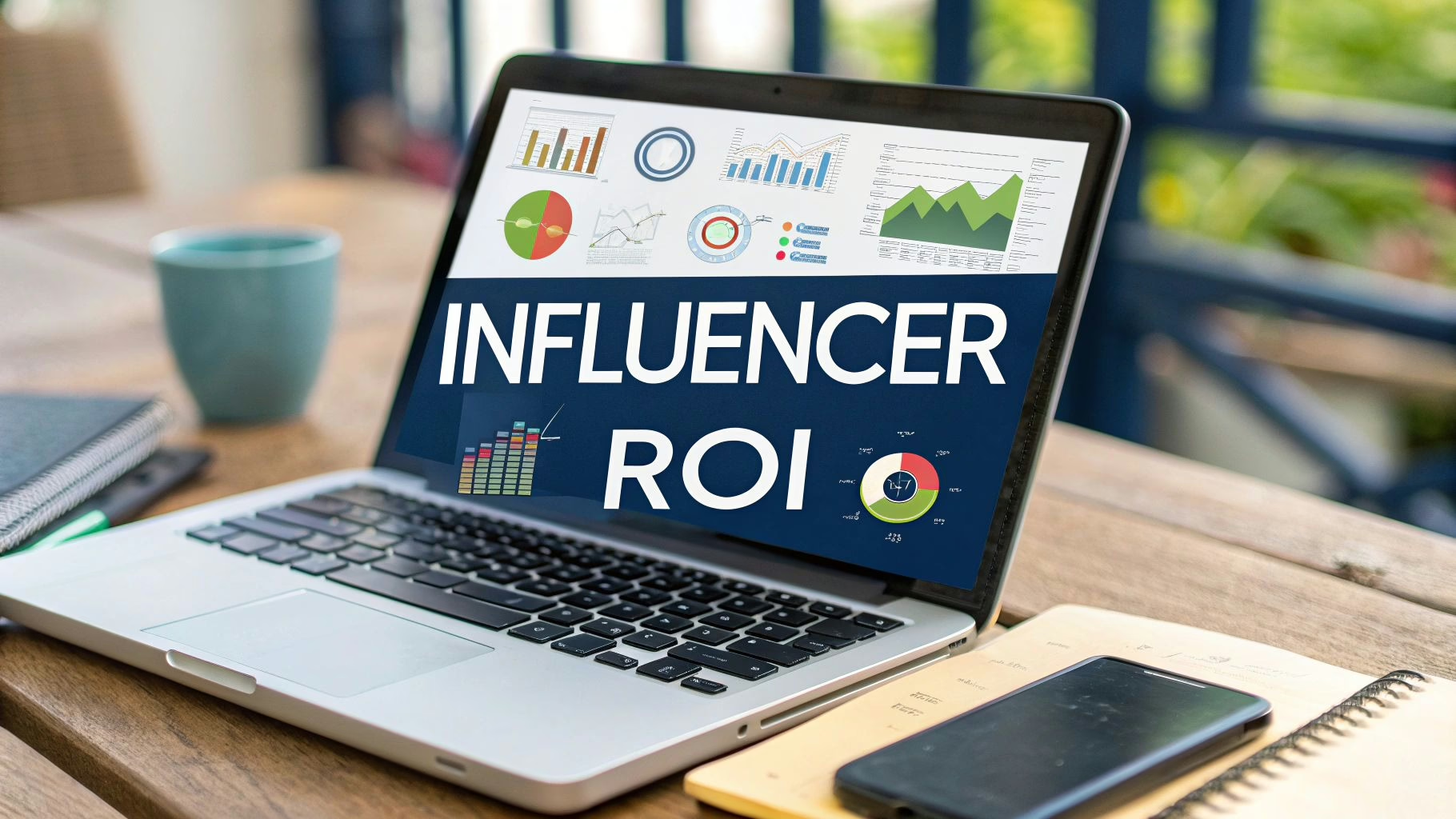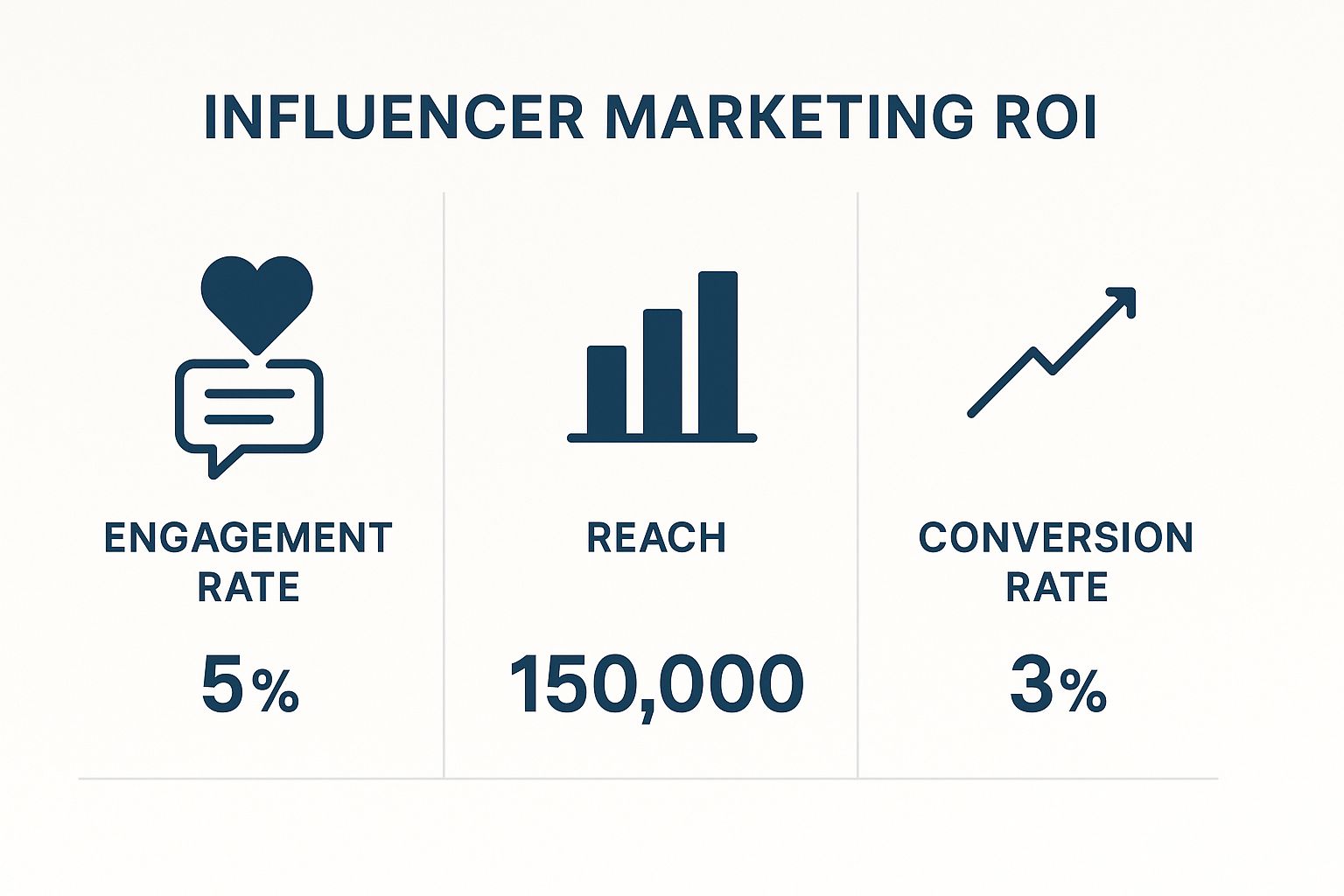Why ROI Measurement Transforms Your Influencer Strategy
Measuring influencer marketing ROI isn’t simply a reporting task; it’s the foundation of a successful strategy. While many brands still rely on intuition, a data-driven approach is crucial for achieving real results. This means shifting focus from vanity metrics like follower count to tangible business outcomes. This section explores why ROI measurement is essential and how it can turn your campaigns into reliable revenue generators.
From Vanity Metrics to Valuable Insights
Many brands pursue superficial metrics, but true success lies in understanding how influencer activities impact the bottom line. Effectively measuring influencer marketing ROI depends on focusing on metrics directly linked to business goals, such as conversions, sales, and customer acquisition cost. This allows for real-time campaign optimization and efficient budget allocation. For example, if a particular influencer consistently drives more conversions, you can increase investment in similar partnerships.
Unlocking the Power of Predictability
Understanding your ROI transforms influencer marketing from an experimental tactic into a predictable revenue source. By analyzing past campaign performance, you can forecast future results and make informed decisions. This allows for more strategic budget allocation, prioritizing influencer partnerships and content formats with a proven track record. Furthermore, measuring ROI allows you to continuously refine your strategy, improving results and maximizing the impact of your influencer investments.
The Competitive Edge of Measurement
Leading agencies and brands recognize that meticulous ROI tracking provides a significant competitive advantage. They use data to refine their selection criteria, choosing influencers based on demonstrated performance rather than mere popularity. This helps them identify influencers who genuinely resonate with their target audience and deliver measurable results. They can also confidently demonstrate the value of their work to clients and stakeholders with concrete data, building trust and credibility.
Avoiding Costly Mistakes
Measuring ROI helps identify and avoid common pitfalls that deplete marketing budgets. For instance, you might discover that investing in mega-influencers isn’t yielding the expected returns compared to micro-influencers with higher engagement rates. This knowledge empowers you to adjust your strategy and prioritize collaborations that offer the best value. Analyzing campaign data also reveals which content strategies are most effective, allowing for real-time adjustments and preventing wasted ad spend. This ensures your influencer marketing budget is used efficiently, maximizing impact and minimizing unnecessary expenses.
Metrics That Actually Predict Campaign Success
Understanding true influencer marketing ROI requires moving beyond vanity metrics like follower counts. Instead, focus on metrics that directly reflect business impact. This involves analyzing engagement, reach, and conversion data. This section explores the crucial metrics that predict campaign success and how to use them effectively to evaluate your influencer partnerships.
Engagement: Beyond Likes and Comments
While likes and comments provide a surface-level view of engagement, assessing the quality of these interactions is paramount. Look for meaningful conversations, shares, and saved content, all indicative of genuine audience interest.
For example, a high number of shares suggests the audience values the content enough to share it within their own networks. This authentic engagement is a far better indicator of campaign effectiveness than superficial likes.
Reach and Impressions: Expanding Your Brand’s Footprint
Reach and impressions are valuable for understanding potential audience exposure to your brand message. Reach represents the unique number of individuals who saw your content. Impressions represent the total number of times the content was displayed.
However, analyze these metrics alongside engagement data for an accurate assessment. High reach with low engagement could signal a mismatch between the influencer’s audience and your target demographic.
Conversion Tracking: Connecting Influence to Action
Influencer marketing ultimately aims to drive actions like website visits, purchases, or sign-ups. Implementing robust conversion tracking is crucial for measuring ROI.
Use trackable links, unique discount codes, or dedicated landing pages. This allows you to directly link conversions to specific influencer activities and calculate the financial return. This data demonstrates the value of influencer marketing and optimizes future campaigns.
Return on Investment (ROI): Measuring the Impact
One significant way to measure influencer marketing ROI is through the engagement rate. This metric reflects how well the audience interacts with the content. Micro-influencers often have higher engagement rates than larger influencers, potentially leading to more effective campaigns. Brands often see a substantial return when partnering with influencers who have a strong audience connection. Some statistics suggest brands can earn up to $4.12 for every $1 spent on influencer campaigns on platforms like Instagram. Find more detailed statistics here: https://www.dash.app/blog/influencer-marketing-statistics
Micro-Influencers: The ROI Powerhouse
Micro-influencers, with smaller but highly engaged audiences, often deliver superior ROI compared to mega-influencers. Their niche focus and authentic follower connections translate to higher conversion rates and a more cost-effective strategy.
This makes them valuable for reaching specific demographics and building brand loyalty. Carefully selecting micro-influencers aligned with your brand and target audience maximizes campaign impact and achieves measurable results.
Mastering ROI Calculations That Drive Real Decisions
This infographic visualizes key influencer marketing ROI metrics: Engagement Rate, Reach, and Conversion Rate. Balancing these three is crucial for maximizing ROI. High reach expands brand visibility, but strong engagement and conversions ultimately determine campaign profitability. This highlights the need to choose influencers who not only have a broad audience but also resonate deeply enough to encourage action.
Calculating the Core ROI Metric
Calculating your basic Return on Investment (ROI) for influencer marketing is straightforward: (Net Profit / Total Investment) * 100.
For instance, a campaign generating $10,000 in profit from a $2,000 investment yields a 500% ROI. This calculation provides a clear snapshot of your campaign’s overall profitability. For further information, check out this resource on how to master influencer ROI tracking.
Diving Deeper With RoAS and CPA
Beyond basic ROI, Return on Ad Spend (RoAS) and Cost Per Acquisition (CPA) offer more detailed insights. RoAS, calculated as (Revenue / Ad Spend), reveals the revenue generated per dollar spent on influencers.
CPA, calculated as (Total Cost / Number of Acquisitions), identifies the cost of each new customer acquired through influencer marketing. These metrics help refine campaign efficiency and optimize budget allocation. Influencer marketing ROI can also be assessed through RoAS and CPA. RoAS directly indicates campaign efficiency, showcasing revenue generated per dollar spent.
A successful campaign should have a RoAS comparable to paid ads on platforms like Meta or TikTok. A benchmark is a RoAS of at least 1.5x, meaning every $1 spent earns the brand $1.50 or more. Explore this topic further.
The Long-Term View: Customer Lifetime Value
While immediate returns are crucial, Customer Lifetime Value (CLTV) provides a longer-term ROI perspective. CLTV estimates the total revenue generated by a customer throughout their relationship with your brand.
Influencer marketing, with its ability to foster lasting brand affinity, can significantly influence CLTV. Tracking CLTV alongside RoAS and CPA offers a complete view of your campaigns’ short-term and long-term effects. This enables strategic investment in influencers who drive both immediate conversions and build customer loyalty.
Benchmarking and Objective Alignment
Setting realistic benchmarks for influencer marketing ROI is crucial for evaluating success. These should be based on your industry, target audience, and campaign goals. Aligning ROI calculations with clear objectives is essential. For example, a brand awareness campaign might prioritize reach and engagement, while a sales-focused campaign emphasizes conversions and RoAS.
This ensures you measure the right metrics and make informed decisions that support your overall business goals. The following table summarizes various ROI calculation methods.
To help illustrate the different approaches to calculating ROI, the table below offers a comparison of several common methods. Each method is presented with its formula, ideal use case, advantages, and limitations, giving you a comprehensive overview of how to choose the most suitable calculation for your needs.
ROI Calculation Methods Comparison
| Method | Formula | Best Use Case | Advantages | Limitations |
|---|---|---|---|---|
| ROI | (Net Profit / Total Investment) * 100 | Measuring overall campaign profitability | Simple, easy to understand | Doesn’t account for specific actions or customer lifetime value |
| RoAS | Revenue / Ad Spend | Assessing campaign efficiency in generating revenue | Direct indicator of return on ad spend | May not reflect long-term brand building effects |
| CPA | Total Cost / Number of Acquisitions | Determining the cost of acquiring a new customer | Useful for optimizing budget allocation | Can be difficult to track accurately without proper attribution |
| CLTV | (Average Purchase Value * Average Purchase Frequency * Average Customer Lifespan) | Evaluating long-term customer value and campaign impact | Provides a holistic view of customer relationships | Requires historical data and can be complex to calculate |
This table highlights the key differences and similarities between various ROI calculations, offering a practical guide for selecting the right method based on specific campaign objectives. By understanding the strengths and weaknesses of each approach, marketers can make more informed decisions about influencer selection, budget allocation, and overall campaign strategy.
Choosing Influencers Who Deliver Measurable Results
Not all influencers are created equal. Some drive significant ROI, while others may not deliver tangible results. This section explores the data-driven criteria that distinguish profitable influencer partnerships from underperforming ones. We’ll look beyond follower counts and delve into evaluating audience quality, content alignment, and conversion potential.
Beyond Follower Count: Assessing Audience Quality
Follower count can be misleading. An influencer with millions of followers might have low engagement, suggesting a less invested audience. Instead of focusing on large numbers, prioritize audience quality. This involves analyzing factors like:
- Demographic Alignment: Does the influencer’s audience match your target customer?
- Engagement Rate: How actively does the audience interact with the influencer’s content?
- Authenticity: Does the influencer have genuine connections with their followers?
A smaller, highly engaged audience is often more valuable than a large, passive one.
Content Alignment and Brand Fit
An influencer’s content should resonate with your brand’s values and messaging. This synergy creates authenticity and resonates with the audience. Consider factors like:
- Content Style: Does the influencer’s style match your brand’s aesthetic and tone?
- Values Alignment: Does the influencer share your brand’s values and beliefs?
- Previous Brand Partnerships: Has the influencer partnered with similar brands?
Strong content alignment strengthens brand message credibility and increases positive audience reception. You might be interested in: How to master Influencer Relationship Management.
Conversion Potential: From Engagement to Action
Influencer marketing aims to drive conversions. When choosing influencers, assess their potential to motivate their audience to take specific actions. Consider:
- Call to Action Effectiveness: How well does the influencer incorporate calls to action?
- Past Campaign Performance: Has the influencer driven conversions for other brands?
- Audience Purchasing Behavior: Is the influencer’s audience likely to buy your product or service?
An influencer’s ability to inspire action—visiting your website, making a purchase, or subscribing to a newsletter—is key for measurable ROI. This also involves examining their overall content strategy.
Data-Driven Selection for Measurable Impact
Prioritizing audience quality, content alignment, and conversion potential enables data-driven influencer selection. This approach ensures your investments yield measurable results and contribute to your business objectives. Choosing the right influencers is crucial for maximizing ROI and building successful, long-term partnerships. Research shows a strong correlation between follower count and ROI. A study by Shopify highlighted that brands see a 9.2% better return when working with influencers with larger followings. Content also plays a key role. While website links positively impact ROI, new product announcements can decrease ROI by 30.5%.
Tools And Platforms For Accurate ROI Tracking
Accurately tracking your influencer marketing ROI requires having the right tools. This section explores a range of platforms, from native analytics dashboards to dedicated third-party solutions, highlighting their strengths and weaknesses. We’ll also discuss how to build a tracking infrastructure that captures meaningful data without overwhelming you with complex reports.
Native Platform Analytics: A Starting Point
Most social media platforms, like Instagram, offer built-in analytics dashboards. These provide basic data on reach, impressions, and engagement. They’re a good starting point for understanding how your content performs on each individual platform. For example, Instagram Insights offers valuable data on audience demographics and post-level performance.
However, native analytics are often limited. They struggle to track conversions and attribute sales directly to influencer activity. This can make it difficult to get a truly complete picture of your ROI.
Third-Party Influencer Marketing Platforms: Comprehensive Measurement
Dedicated influencer marketing platforms offer more comprehensive measurement solutions. These platforms often include features designed to streamline the entire tracking process.
- Automated Tracking: Automatically collect data from multiple platforms and campaigns.
- Conversion Tracking: Track website visits, sales, and other conversions driven by influencer content.
- ROI Calculation: Calculate ROI based on various metrics, including Return on Ad Spend (RoAS) and Cost Per Acquisition (CPA).
- Reporting and Analysis: Generate customized reports to help visualize campaign performance and identify areas for improvement.
These platforms streamline data collection and analysis, providing much deeper insights into your influencer marketing ROI. Some platforms even offer predictive analytics, which can help estimate the potential ROI of future campaigns.
Integrating Multiple Data Sources for a Holistic View
For a truly complete understanding of your influencer marketing ROI, integrating multiple data sources is often necessary. This might involve combining data from native platform analytics, third-party influencer marketing platforms, and your own internal sales data. This approach lets you see the full customer journey, from initial exposure to final conversion. You might be interested in: How to master influencer marketing KPIs.
This holistic view can reveal valuable insights into how different influencer activities contribute to your overall marketing goals. For example, you might discover that an influencer’s content is driving significant website traffic, even if it’s not directly leading to sales.
Maintaining Accuracy and Avoiding Common Pitfalls
Accurate ROI tracking requires careful attention to detail. Here are some common pitfalls to avoid:
- Relying solely on vanity metrics: Follower counts and likes don’t tell the whole story. Focus on metrics tied to business outcomes, such as conversions and sales.
- Ignoring organic reach: Influencer marketing can have a ripple effect, influencing organic performance. Consider using control groups to isolate the impact of specific influencer campaigns.
- Inconsistent tracking methods: Use consistent tracking methods across all campaigns to ensure accurate comparisons and meaningful analysis.
By avoiding these pitfalls, you can build a reliable tracking infrastructure that accurately measures the real impact of your influencer marketing efforts. This empowers you to optimize your campaigns and maximize your ROI.
Choosing the Right Tools for Your Needs
The best tools for tracking your influencer marketing ROI depend on your specific needs and budget. If you’re just starting out, native analytics might be sufficient. However, as your influencer marketing program grows, investing in a dedicated platform can provide the comprehensive data and advanced insights you need to scale effectively.
To understand which solution works best for your business, consider the following factors:
- Program Size: How many influencers are you working with?
- Campaign Complexity: Are you running multiple campaigns across different platforms?
- Reporting Requirements: What level of detail and analysis do you need?
Carefully evaluating your needs ensures that you choose tools that provide the data you need to make informed decisions and achieve your marketing goals.
To help you in the decision-making process, take a look at the comparison table below:
Understanding the nuances of each tool can help you determine which best aligns with your specific business objectives.
ROI Tracking Tools Comparison
Side-by-side comparison of leading influencer marketing measurement platforms with pricing, features, and suitability for different business sizes.
| Tool | Key Features | Pricing Range | Best For | Integration Options |
|---|---|---|---|---|
| Influencer Marketing Hub | Influencer discovery, campaign management, ROI tracking, analytics dashboard | $99 – $999/month | Businesses of all sizes | Social media platforms, CRM, e-commerce platforms |
| Upfluence | Influencer search engine, relationship management, campaign tracking, analytics & reporting | Contact for pricing | Medium to large businesses | Social media platforms, CRM, Google Analytics |
| AspireIQ | Influencer relationship management, product seeding, campaign tracking, analytics & reporting | Contact for pricing | Enterprise businesses | CRM, e-commerce platforms |
| Grin | Influencer relationship management, content planning, campaign execution, analytics & reporting | Contact for pricing | Large businesses | Social media platforms, CRM, e-commerce platforms |
This table provides a high-level overview of several popular influencer marketing platforms. Be sure to research each platform thoroughly to determine which best meets your unique needs and budget. Each platform offers a different set of capabilities and pricing structures, so it’s important to choose the one that aligns with your specific business requirements.
Scaling ROI-Driven Influencer Programs That Last
Successfully scaling influencer marketing programs without sacrificing ROI requires a strategic approach. This means thinking beyond one-off campaigns and focusing on sustainable, long-term partnerships. This section explores how brands can maintain ROI quality while increasing their reach and budget. We’ll examine the systematic approaches that successful companies use to scale their influencer marketing efforts while preserving performance.
Building Sustainable Influencer Relationships
Effective scaling depends on nurturing strong, lasting relationships with key influencers. This goes beyond simple transactions and focuses on building genuine connections.
- Open Communication: Communicate regularly with influencers, providing feedback and soliciting their input.
- Value Exchange: Offer influencers more than just money. Consider exclusive access to products, events, or valuable brand information.
- Mutual Growth: Support influencers’ own growth and development. This could involve cross-promotion, collaborative content creation, or even introductions to other brands.
These strategies foster loyalty and encourage influencers to become long-term brand advocates. This provides a solid base for scaling your program without impacting quality.
Strategic Budget Distribution for Scalability
Expanding your program requires a thoughtful budget distribution strategy. Consider these key elements:
- Performance-Based Allocation: Increase investment in influencers with a proven track record of high ROI.
- Diversification: Explore new influencer tiers and platforms to broaden reach and reduce risk.
- Testing and Optimization: Continuously test different approaches and analyze the results. This helps identify the most effective budget allocation strategies as your program grows.
This data-driven approach allows for efficient budget scaling, maximizing returns at each stage.
Maintaining Quality Control While Scaling
Scaling often introduces the risk of diluted quality. To mitigate this, maintain strict quality control measures.
- Clear Guidelines: Set clear expectations for content quality, brand alignment, and posting frequency.
- Content Review Process: Implement a system for reviewing influencer content before it’s published. This ensures consistency and prevents brand misrepresentation.
- Performance Monitoring: Continuously monitor influencer performance, tracking metrics like engagement, reach, and conversions. This enables early identification of any quality dips.
These proactive steps help maintain high-quality content and brand integrity as your program expands.
Systematizing Processes for Enterprise-Level Growth
Scaling to the enterprise level requires systematizing key processes:
- Influencer Onboarding: Create a streamlined onboarding process for new influencers. This might include providing brand guidelines, content calendars, and access to necessary resources.
- Campaign Management: Use project management software to organize campaigns, track deliverables, and manage communication with multiple influencers.
- Reporting and Analytics: Use dashboards and automated reports to monitor campaign performance, track ROI, and identify improvement areas.
These systematic approaches ensure efficiency and consistency as the program grows, creating a foundation for sustained, long-term success. As influencer marketing continues to grow, a recent Meltwater blog post highlights that 17% of companies allocate over half of their marketing budgets to influencers. This underscores the increasing importance of strategic scaling for maximizing returns. Furthermore, 89% of marketers find influencers at least as effective as other marketing channels, further reinforcing the value of well-structured influencer programs.
Avoiding Common Scaling Pitfalls
Understanding potential challenges is vital for successful scaling. Common pitfalls include:
- Relationship Fatigue: Over-reliance on a small group of influencers can lead to burnout and decreased performance. Diversify your influencer pool to avoid this.
- Quality Dilution: Maintaining consistent content quality can be challenging as your program grows. Implement clear guidelines and review processes to address this.
- Measurement Complexity: Tracking ROI across multiple campaigns and influencers can become complicated. Use robust tracking tools and platforms to simplify data collection and analysis.
By proactively addressing these potential issues, you can build a scalable, ROI-driven influencer program that delivers consistently strong returns as it expands.
Key Takeaways
This section offers a practical guide to implementing influencer marketing strategies focused on Return on Investment (ROI), complete with actionable steps and realistic benchmarks. You’ll find clear checklists for campaign setup, measurement frameworks, and performance optimization. Each takeaway emphasizes immediately applicable strategies, accompanied by straightforward success indicators and potential warning signs. We also provide honest guidance on setting achievable expectations and establishing sustainable measurement practices for your long-term influencer marketing strategy.
Focus on Business Outcomes, Not Vanity Metrics
Shift your focus from surface-level metrics like follower count to concrete business results. Track conversions, sales, and customer acquisition costs to directly quantify the impact of your influencer campaigns on your profits. For instance, if an influencer’s post results in a significant increase in website traffic and subsequent sales, this clearly demonstrates a positive ROI.
Choose the Right Metrics for Your Goals
Different campaign objectives necessitate different metrics. For brand awareness campaigns, monitor reach, impressions, and engagement. For sales-driven campaigns, concentrate on conversions, Return on Ad Spend (RoAS), and Cost Per Acquisition (CPA). Aligning your metrics with your goals ensures you’re measuring what truly matters for your business objectives.
Implement Robust Tracking Mechanisms
Use multiple tracking methods for a comprehensive understanding of your ROI. Utilize affiliate links, UTM parameters, unique discount codes, and dedicated landing pages to accurately attribute conversions to specific influencer actions. These tools provide the data needed for precise ROI calculations.
Evaluate Audience Quality, Not Just Size
Look beyond the number of followers and assess the quality of an influencer’s audience. Analyze demographic alignment, engagement rate, and authenticity to determine if their followers are truly your ideal customers. A smaller, highly engaged audience can often deliver better results and higher ROI than a large, uninterested one.
Build Long-Term Influencer Relationships
Invest in cultivating long-term relationships with key influencers. Open communication, mutually beneficial partnerships, and collaborative content creation foster loyalty and can transform influencers into dedicated brand advocates. These enduring relationships often generate higher ROI over time compared to one-off campaigns.
Leverage Influencer Content Across Channels
Maximize your ROI by repurposing effective influencer content across your own marketing platforms. Share influencer-generated content on your website, social media profiles, and email newsletters to broaden your reach and maximize impact. This economical strategy helps stretch your influencer marketing budget.
Continuously Analyze and Optimize
Regularly evaluate campaign performance and make data-driven adjustments to your influencer marketing approach. Identify high-performing influencers, content formats, and platforms to optimize future campaigns and boost your ROI. Meltwater offers tools that can assist in campaign analysis.
Realistic ROI Expectations
Establish realistic expectations for your influencer marketing ROI. Benchmarks vary across industries, target demographics, and specific campaign goals. Don’t anticipate immediate, dramatic results. Building a successful influencer program requires time, consistent effort, and ongoing optimization. Storyclash offers resources on setting realistic influencer marketing goals.
Choose the Right Tools for Your Needs
Select influencer marketing tools and platforms that fit your budget and requirements. While native platform analytics offer basic data, dedicated influencer marketing platforms often provide more comprehensive tracking and reporting features. Consider your program’s scale, campaign complexity, and reporting needs when deciding. Platforms like Influencer Marketing Hub, Upfluence, AspireIQ, and Grin provide a range of options.
Start Scaling Your Influencer Marketing ROI Today
REACH Influencers is an influencer marketing platform designed to connect brands with content creators of all sizes. It allows businesses to launch targeted campaigns that engage motivated micro and nano influencers within specific demographics. With a user-friendly interface, REACH simplifies campaign setup, management, and payments, while also offering free access for influencers to monetize their social media presence. Start scaling your influencer marketing ROI today with REACH Influencers: https://reach-influencers.com






